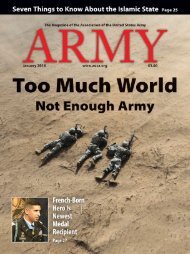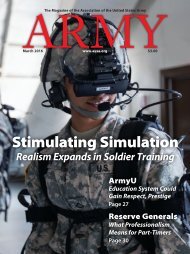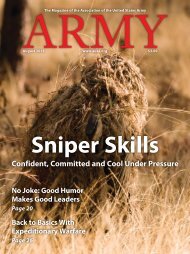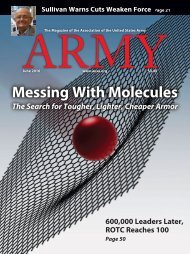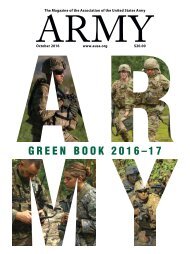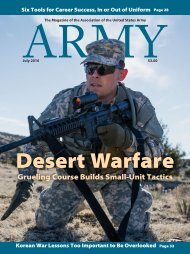Army - Kicking Tires On Jltv
You also want an ePaper? Increase the reach of your titles
YUMPU automatically turns print PDFs into web optimized ePapers that Google loves.
pects of fire control and fire distribution (many young leaders<br />
have first-person experience in this), and developing a live-fire<br />
training event that allows for decisionmaking to achieve desired<br />
effects of their weapon systems. Young leaders arguably<br />
do not have experience in designing the training that tests the<br />
full range of capabilities; however, they certainly possess the<br />
context to understand why this is important. Coaching them<br />
through the “art” will achieve and maximize learning.<br />
Finally, there has been resurgence in the philosophy of<br />
Mission Command that has shaped the way in which leaders<br />
at all levels train their formations. While <strong>Army</strong> Doctrine<br />
Publication 6-0 Mission Command is a relatively new member<br />
to the doctrine family, the idea has been around for a while.<br />
The 1941 edition of Field Manual 100-5 Field Service Regulations,<br />
Operations, states, “Every individual must be trained<br />
to exploit a situation with energy and boldness, and must be<br />
imbued with the idea that success will depend upon his initiative<br />
and action.”<br />
Over five decades later, in a 1992 issue of Military Review,<br />
then-Lt. Col. James M. Dubik argued that for units to operate<br />
decentralized in battle, commanders need to develop the culture<br />
in garrison. (Dubik retired as a lieutenant general and is a<br />
contributing editor for ARMY magazine.) Some could argue<br />
that aspects of the larger <strong>Army</strong> culture in the late ’90s reflected<br />
the opposite of the two examples cited. Training became more<br />
centralized, with the end state being effective training management<br />
and not a preparedness to operate decentralized in battle.<br />
The tactical lessons of Iraq and Afghanistan taught leaders<br />
that developing and nurturing the philosophy of Mission<br />
Command in training was critical to success in combat. Even<br />
though units are no longer on the constant rotation, this culture<br />
has transferred to home-station training. Dubik’s 1992 vision<br />
for a decentralized command is no longer the exception<br />
to the rule.<br />
Incorporate Mission Command<br />
Commanders, from the company through the brigade, understand<br />
that the principles of Mission Command must be incorporated<br />
into all aspects of training. Battalion and brigade<br />
commanders develop multiechelon training to build cohesive<br />
teams through mutual trust. Company commanders and first<br />
sergeants plan training in conjunction with their squad leaders<br />
to create shared understanding. Disciplined initiative and prudent<br />
risks must be valued over adherence to an <strong>Army</strong> training<br />
and evaluation program.<br />
A new generation is already emerging in the ranks of our<br />
<strong>Army</strong>. The squad, platoon and even company host leaders and<br />
soldiers who do not have experience in Iraq and Afghanistan.<br />
This should not be a source of concern. In fact, this very condition<br />
requires combat-seasoned leaders to reflect on how they<br />
can effectively train their subordinates for the rigors of combat<br />
without relying on “how we did it overseas.” Ultimately, effective<br />
training meets published standards, tests the full range of<br />
our capabilities, challenges decisionmaking skills, builds cohesive<br />
teams, and instills confidence in soldiers and leaders. As it<br />
was following Operation Desert Storm, it remains the responsibility<br />
of all leaders to teach subordinates how to fight and<br />
how to train. Assume nothing. By teaching your subordinates<br />
how to train correctly, you have a direct effect on ensuring that<br />
tomorrow’s <strong>Army</strong> stays as good as today’s. ✭<br />
Soldiers check vehicles at Fort Carson, Colo.<br />
48 ARMY ■ February 2016




